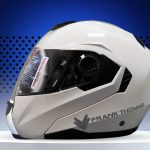The most important thing to consider when choosing your helmet isn’t the brand name or how it looks. The secret to providing yourself better head protection is in getting the right fit.
A comprehensive study of motorcycle accidents across Europe showed that 12% of helmets were lost during the course of the impact (COST 327(2001) Final Report of the Action). Wearing a helmet that fits correctly dramatically increases your chances of surviving a crash.
After all, even a SHARP five-star helmet won’t protect you if it’s not on your head at the point of impact.
Fitting guide
We recommend you invest time trying on as many helmets as possible. Once you’ve found those that fit you best, you can then choose the helmet with the highest SHARP rating for the best possible protection.
Every head shape is different, so we’ve pulled together some tips to help you choose the right fit.
| Get measured | Your safety is too important to simply guess your size. Before trying on any helmets you need to make sure you know your exact head size. Measure around your head just above the ears and take a measurement at the forehead. This measurement is a good starting point and will correspond with a particular brand’s size (always bear in mind a medium in one brand may be different to a medium in another). Getting the right fit is paramount, so don’t be tempted to go for another size if your dream helmet is out of stock. |
|---|---|
| Try it on | Ok, so you’ve chosen a helmet to try. Now place it firmly on your head and secure the chin strap; the chin strap should be tight enough so you can still open and close your mouth. If the helmet has a quick release buckle then take your time adjusting the strap. Once on, you should be able to feel the helmet against the whole of your head – without feeling ‘pressure points’ or the helmet leaving red marks. Once you’re happy, keep it on for a few minutes to make sure it’s comfortable. |
| Check the fit | Secure the strap and try rotating the helmet from side to side. If you’re wearing a full-face helmet your cheeks should follow the helmet’s movement, while remaining in contact with the cheek pads firmly and comfortably. If the helmet moves or slips on your head it’s probably the wrong size. Next, try tilting the helmet forwards and backwards. Again, if it moves or slips it’s probably the wrong size. |
| Will it stay on? | You want to know the helmet you buy will stay firmly on your head in a crash. Make sure the chinstrap is done up and tilt your head forward. Ask someone to try and roll the helmet off your head by carefully pushing up from the rear of the helmet at its base. If you can roll it off in the showroom, then it’s sure to come off in a crash. |






